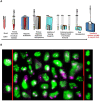Circulating tumor cells in breast cancer: a tool whose time has come of age
- PMID: 21510857
- PMCID: PMC3107794
- DOI: 10.1186/1741-7015-9-43
Circulating tumor cells in breast cancer: a tool whose time has come of age
Abstract
Circulating tumor cells (CTCs) are isolated tumor cells disseminated from the site of disease in metastatic and/or primary cancers, including breast cancer, that can be identified and measured in the peripheral blood of patients. As recent technical advances have rendered it easier to reproducibly and repeatedly sample this population of cells with a high degree of accuracy, these cells represent an attractive surrogate marker of the site of disease. Currently, CTCs are being integrated into clinical trial design as a surrogate for phenotypic and genotypic markers in correlation with development of molecularly targeted therapies. As CTCs play a crucial role in tumor dissemination, translational research is implicating CTCs in several biological processes, including epithelial to mesenchymal transition. In this mini-review, we review CTCs in metastatic breast cancer, and discuss their clinical utility for assessing prognosis and monitoring response to therapy. We will also introduce their utility in pharmacodynamic monitoring for rational selection of molecularly targeted therapies and briefly address how they can help elucidate the biology of cancer metastasis.
Figures


References
-
- American Cancer Society. Cancer Fact & Figures 2009. 2009. http://www.cancer.gov
-
- National Cancer Institute Surveillance Epidemiology and End Results (SEER) Cancer survival statistics. http://seer.cancer.gov/statistics
-
- Honig SF. In: Disease of the Breast. Harris JR, Lippman ME, Morrow M, et al, editor. Philadelphia, PA: Lippincott-Raven; 1996. Treatment of metastatic disease; pp. 669–734.
-
- Recamier JCA. L'histoire de le Meme Maladie. Gabor. 1829. p. 110.
Publication types
MeSH terms
LinkOut - more resources
Full Text Sources
Other Literature Sources
Medical
Research Materials

